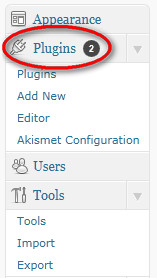 We’ve gone over Themes and Widgets for customizing your WordPress site, and now we move on to the most impressive facet of WordPress: Plugins. Plugins are simply WordPress add-ons and customizations that are developed by mostly by outside developers and but also by WordPress. The plugins can range from simple to very specific. You may be asking yourself why plugins aren’t automatically included, well, WordPress has left them as an extra so you have the option of making your blog or site as basic or complex as you like.
We’ve gone over Themes and Widgets for customizing your WordPress site, and now we move on to the most impressive facet of WordPress: Plugins. Plugins are simply WordPress add-ons and customizations that are developed by mostly by outside developers and but also by WordPress. The plugins can range from simple to very specific. You may be asking yourself why plugins aren’t automatically included, well, WordPress has left them as an extra so you have the option of making your blog or site as basic or complex as you like.
Plugins on WordPress can do almost anything you would like your site to do. You can search for a plugin to make your blogs shareable, create a custom contact form, or link your social media accounts. But this is just the beginning. Want a plug in that will email a new blog visitor? Search for it. It’s there.
To put it simple, WordPress describes their plugins as: “Plugins can extend WordPress to do almost anything you can imagine. In the directory you can find, download, rate, and comment on all the best plugins the WordPress community has to offer.”
Why do I need plugins?
Maybe you don’t: In all honesty, you may not need or use any plugins that are offered. The standard WordPress offering is quite complete and plugins are a bonus for anyone interested.
Maybe you do: But, if you want to venture into the world of plugins, simply search for what you may want to add to your blog. Looking for a way to share your blog on social bookmarking sites? Navigate to the plugin link on your dashboard and then search “share,” or for specific service, “ShareThis,” which is what this blog uses at then end of each post. Another great plugin is Akismet, which can be free or you can chose to donate a certain amount. Akismet operates only on the backend of your site and monitors your blog comments and keeps spam posts from being posted and driving you nuts. If these two offerings sound great to you, it’s time to learn how to get started with plugins.
How do I use them?
Search for Your Plugin: The easiest way to search for, download and activate plugins is right through your WordPress dashboard. Navigate to Plugins>Add New and then search for what you may need. Perhaps it is a program that will share your recent Tweets in the sidebar of your blog, like this blog has. You would Search: “Twitter” and browse through the results. Read the descriptions of the plugins to ensure you are one the right path. Also be sure to read reviews on each plugin, because most are developed by outside sources and may not be the best option. Once you see a plugin you would like, click “Install Now.”
Activate Your Plugin: If the plugin is something that will appear on the front end of your site, like the recent tweets plugin you can see on this blog, then it will show up in your widgets area once it is downloaded. Then you will treat is like a widget with the drag, drop and customizing you learned about in this past post. If the widget is something that will only work on the backend of your site, like Akismet, you will just need to activate the plugin in the plugin area as it will not appear on your front end.
Be sure to check the front end for changes and check the back end of Twitter to see if programs like Akismet are working.
Good Luck and leave any questions you have about WordPress Plugins in the comments!
